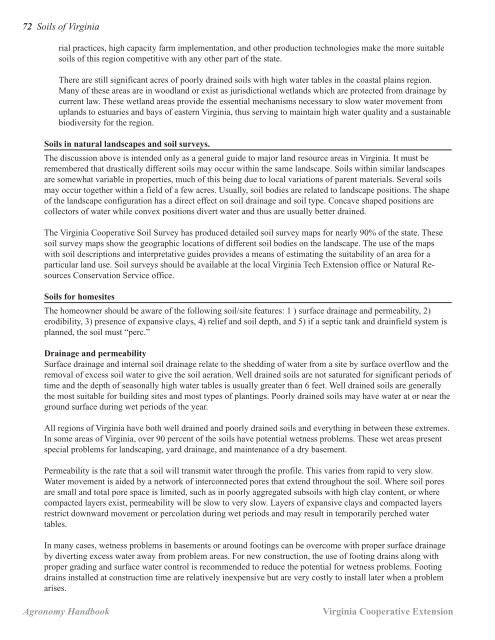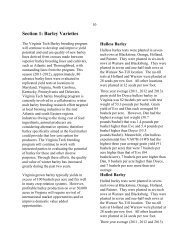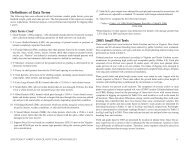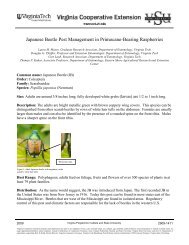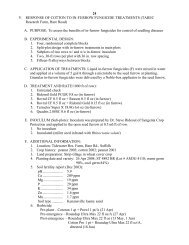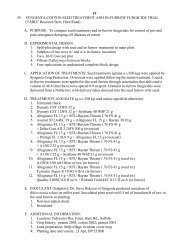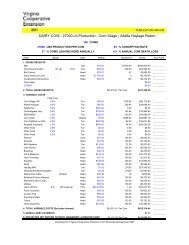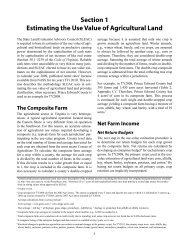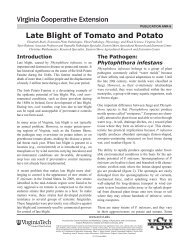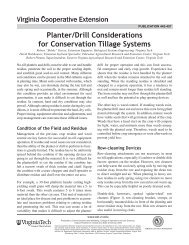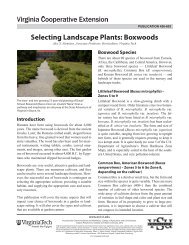PM Part VI-Soils of Virginia - Virginia Cooperative Extension ...
PM Part VI-Soils of Virginia - Virginia Cooperative Extension ...
PM Part VI-Soils of Virginia - Virginia Cooperative Extension ...
You also want an ePaper? Increase the reach of your titles
YUMPU automatically turns print PDFs into web optimized ePapers that Google loves.
72 <strong>Soils</strong> <strong>of</strong> <strong>Virginia</strong><br />
rial practices, high capacity farm implementation, and other production technologies make the more suitable<br />
soils <strong>of</strong> this region competitive with any other part <strong>of</strong> the state.<br />
There are still significant acres <strong>of</strong> poorly drained soils with high water tables in the coastal plains region.<br />
Many <strong>of</strong> these areas are in woodland or exist as jurisdictional wetlands which are protected from drainage by<br />
current law. These wetland areas provide the essential mechanisms necessary to slow water movement from<br />
uplands to estuaries and bays <strong>of</strong> eastern <strong>Virginia</strong>, thus serving to maintain high water quality and a sustainable<br />
biodiversity for the region.<br />
<strong>Soils</strong> in natural landscapes and soil surveys.<br />
The discussion above is intended only as a general guide to major land resource areas in <strong>Virginia</strong>. It must be<br />
remembered that drastically different soils may occur within the same landscape. <strong>Soils</strong> within similar landscapes<br />
are somewhat variable in properties, much <strong>of</strong> this being due to local variations <strong>of</strong> parent materials. Several soils<br />
may occur together within a field <strong>of</strong> a few acres. Usually, soil bodies are related to landscape positions. The shape<br />
<strong>of</strong> the landscape configuration has a direct effect on soil drainage and soil type. Concave shaped positions are<br />
collectors <strong>of</strong> water while convex positions divert water and thus are usually better drained.<br />
The <strong>Virginia</strong> <strong>Cooperative</strong> Soil Survey has produced detailed soil survey maps for nearly 90% <strong>of</strong> the state. These<br />
soil survey maps show the geographic locations <strong>of</strong> different soil bodies on the landscape. The use <strong>of</strong> the maps<br />
with soil descriptions and interpretative guides provides a means <strong>of</strong> estimating the suitability <strong>of</strong> an area for a<br />
particular land use. Soil surveys should be available at the local <strong>Virginia</strong> Tech <strong>Extension</strong> <strong>of</strong>fice or Natural Resources<br />
Conservation Service <strong>of</strong>fice.<br />
<strong>Soils</strong> for homesites<br />
The homeowner should be aware <strong>of</strong> the following soil/site features: 1 ) surface drainage and permeability, 2)<br />
erodibility, 3) presence <strong>of</strong> expansive clays, 4) relief and soil depth, and 5) if a septic tank and drainfield system is<br />
planned, the soil must “perc.”<br />
Drainage and permeability<br />
Surface drainage and internal soil drainage relate to the shedding <strong>of</strong> water from a site by surface overflow and the<br />
removal <strong>of</strong> excess soil water to give the soil aeration. Well drained soils are not saturated for significant periods <strong>of</strong><br />
time and the depth <strong>of</strong> seasonally high water tables is usually greater than 6 feet. Well drained soils are generally<br />
the most suitable for building sites and most types <strong>of</strong> plantings. Poorly drained soils may have water at or near the<br />
ground surface during wet periods <strong>of</strong> the year.<br />
All regions <strong>of</strong> <strong>Virginia</strong> have both well drained and poorly drained soils and everything in between these extremes.<br />
In some areas <strong>of</strong> <strong>Virginia</strong>, over 90 percent <strong>of</strong> the soils have potential wetness problems. These wet areas present<br />
special problems for landscaping, yard drainage, and maintenance <strong>of</strong> a dry basement.<br />
Permeability is the rate that a soil will transmit water through the pr<strong>of</strong>ile. This varies from rapid to very slow.<br />
Water movement is aided by a network <strong>of</strong> interconnected pores that extend throughout the soil. Where soil pores<br />
are small and total pore space is limited, such as in poorly aggregated subsoils with high clay content, or where<br />
compacted layers exist, permeability will be slow to very slow. Layers <strong>of</strong> expansive clays and compacted layers<br />
restrict downward movement or percolation during wet periods and may result in temporarily perched water<br />
tables.<br />
In many cases, wetness problems in basements or around footings can be overcome with proper surface drainage<br />
by diverting excess water away from problem areas. For new construction, the use <strong>of</strong> footing drains along with<br />
proper grading and surface water control is recommended to reduce the potential for wetness problems. Footing<br />
drains installed at construction time are relatively inexpensive but are very costly to install later when a problem<br />
arises.<br />
Agronomy Handbook<br />
<strong>Virginia</strong> <strong>Cooperative</strong> <strong>Extension</strong>


